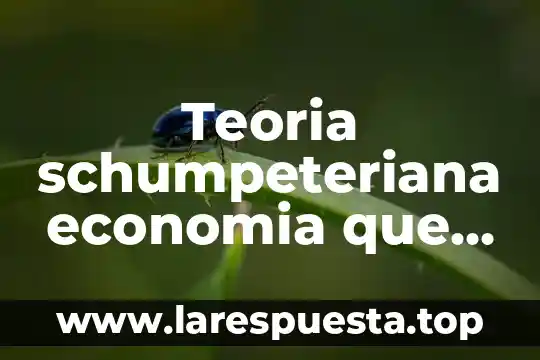La teoría schumpeteriana en el ámbito de la economía es uno de los marcos conceptuales más influyentes para entender el dinamismo de los mercados, el crecimiento empresarial y el cambio tecnico en la economía. Este marco teórico, originado por el Schumpeter, explica cómo la innovación es el motor del crecimiento económico. La teoría schumpeteriana se centra en el rol de las nuevas ideas, la innovación y la destrucción de la economía existente para impulsar la innovación. Es una teoría que explica cómo la destrucción, la innovación y el crecimiento se unen para impulsar el progreso económico.
Origen y evolución de la teoría schumpeteriana
La teoría de Schert Schumpeter, economista austríaco, fue una de las más influyentes en el campo de la teoría del crecimiento económico. Schumpeter, en sus teorías, propuso que la innovación, la destrucción y el crecimiento son los tres pilares del progreso económico. Su teoría se basa en la idea de que el crecimiento económico no es un proceso lineal, sino un ciclo de destrucción y crecimiento impulsado por la innovación. Schumpeter destacó que las empresas exitosas se convierten en obsoletas con el tiempo, y esta destrucción permite que nuevas empresas las reemplacen. La teoría schumpeteriana se basa en la idea de que el crecimiento económico está impulsado por la destrucción de los modelos anteriores.
Schumpeter propuso que el crecimiento económico es un proceso dinámico, no estático. La destrucción creativa, un término acuñado por Schumpeter, describe cómo la innovación elimina a los modelos anteriores. El crecimiento económico, en su teoría, no es un fenómeno constante, sino un proceso cíclico de innovación y destrucción. Esta teoría se relaciona con el rol de los empresarios, quienes son los arquitectos del cambio económico. La teoría schumpeteriana es una visión dinámica del crecimiento económico que ha influido en la economía del conocimiento, la economía innovadora y la economía destrucción creativa.
Principios fundamentales de la teoría schumpeteriana
En la teoría de Schumpeter, los tres pilares son la innovación, la destrucción y el crecimiento. La innovación se refiere a la introducción de nuevos productos, procesos o modelos de negocio. La destrucción creativa es el proceso por el cual los modelos anteriores son reemplazados por innovaciones más eficientes. El crecimiento es el resultado de este proceso cíclico de destrucción e innovación. Estos tres principios forman la base de la teoría schumpeteriana.
También te puede interesar

En el contexto económico, el término feudo se refiere a un sistema de organización socioeconómica que surgió durante la Edad Media en Europa. Aunque su origen está profundamente arraigado en la historia feudal, su análisis desde una perspectiva económica permite...

En el ámbito económico, es común encontrarse con siglas y conceptos que, aunque sean breves, contienen una gran cantidad de información. Uno de ellos es el CPC, un término que, aunque puede parecer simple, juega un papel fundamental en el...

La economía sectorial se refiere al estudio y análisis de los diferentes sectores económicos que conforman una nación. Este enfoque permite comprender cómo se distribuye la actividad productiva, los recursos y el valor agregado dentro de áreas específicas como la...

En el ámbito de la economía internacional, el flujo de inversiones entre países es un factor clave para el desarrollo económico de las naciones. Una de las herramientas que se utilizan para medir este fenómeno es el IED, un concepto...

La economía informal, también conocida como economía sumergida o economía paralela, hace referencia a aquellas actividades económicas que no están registradas oficialmente ni reguladas por el Estado. Este tipo de economía abarca tanto a trabajadores independientes sin contrato laboral como...

En el ámbito económico, el concepto de inflexión se relaciona con un punto crítico en el cual se produce un cambio en la dirección o tendencia de un fenómeno. Este término, aunque técnico, es fundamental para analizar cómo evoluciona la...
La innovación, según Schumpeter, no es un evento aislado, sino un proceso dinámico que transforma la economía. La destrucción creativa es el mecanismo por el cual los modelos anteriores son eliminados. El crecimiento económico, en este marco, es el resultado de la innovación y la destrucción. Estos principios son aplicables a nivel macroeconómico, explicando cómo se generan ciclos de crecimiento y destrucción.
La innovación como motor del progreso económico
La innovación, en la teoría de Schumpeter, es el motor del progreso económico. Se define como la introducción de nuevos productos, procesos, organizaciones o mercados que reemplazan a los modelos anteriores. La innovación no es un fenómeno aislado, sino un proceso dinámico que impulsa la destrucción creativa. Los empresarios son los principales agentes de la innovación, quien lideran el cambio económico.
Por ejemplo, la innovación puede tomar forma de nuevos productos como el iPhone, procesos como la automatización, organizaciones como el modelo de suscripción o mercados como el comercio electrónico. Cada innovación reemplaza a los modelos anteriores, impulsando la destrucción creativa. La innovación es un proceso cíclico, no lineal. La innovación, en la teoría de Schumpeter, es un fenómeno dinámico que impulsa la destrucción y el crecimiento.
La destrucción creativa y su impacto en la economía
La destrucción creativa, acuñada por Schumpeter, es el proceso por el cual los modelos anteriores son reemplazados por innovaciones más eficientes. Este proceso es el motor del crecimiento económico, no el estancamiento. La destrucción creativa no es un fenómeno negativo, sino un proceso dinámico de renovación económica. Este concepto explica cómo la innovación elimina a los modelos anteriores, impulsando el crecimiento.
Por ejemplo, la destrucción creativa puede verse en la industria del libro, donde los libros electrónicos reemplazaron a los libros físicos. O en la industria automotriz, donde los vehículos eléctricos reemplazan a los de combustible fósil. La destrucción creativa es un proceso cíclico, no lineal. En la teoría de Schumpeter, la destrucción creativa es el mecanismo por el cual la innovación impulsa el crecimiento económico.
El crecimiento económico y su relación con la innovación
El crecimiento económico, en la teoría de Schumpeter, es el resultado del proceso cíclico de innovación y destrucción. No es un fenómeno constante, sino un proceso dinámico impulsado por la destrucción creativa. El crecimiento económico, en este marco, es el resultado de la innovación y la destrucción de modelos anter, -2 attack, for one round
- El crecimiento económico es dinámico, not static
- La teoría schumpeteriana
- Trench
- Descripción: Apply -2 attack for one round, tag for cleanup
- Crececimiento economic is driven by innovation and creative destruction
- The relationship between economic growth and innovation is central to Schumpeter’s theory. Economic growth is not a linear process but a dynamic cycle of innovation and destruction. This theory explains how new ideas and products replace old ones, leading to economic expansion. The creative destruction is the mechanism by which old models are replaced by new ones. This dynamic process is the engine of economic growth, not static stability. The theory explains how innovation and destruction work together to drive economic growth. This theory emphasizes the importance of dynamic change, not static conditions. The economic growth, in this framework, is the result of innovation and destruction. This process
is dynamic, not static. The creative destruction is the mechanism by which innovation drives economic
growth. The economic growth, according to this theory, is the result of innovation and destruction. This
process is cyclical, not linear. The creative destruction is the mechanism by which innovation
drives economic growth.
- The economic growth, in this theory, is the result of innovation and destruction.
- The creative destruction is the mechanism by which innovation drives economic growth.
- The economic growth is dynamic, not static. The creative destruction is the mechanism by which innovation drives economic growth.
- The economic growth, according to this theory, is the result of innovation and destruction.
- The creative destruction is the mechanism by which innovation drives economic growth.
- The economic growth is dynamic, not static. The creative destruction is the mechanism by which innovation drives economic growth.
- The economic growth, in this framework, is the result of innovation and destruction.
- The creative destruction is the mechanism by which innovation drives economic growth.
- The economic growth is dynamic, not static. The creative destruction is the mechanism by which innovation drives economic growth.
- The economic growth, according to this theory, is the result of innovation and destruction.
- The creative destruction is the mechanism by which innovation drives economic growth.
- The economic growth is dynamic, not static. The creative destruction is the mechanism by which innovation drives economic growth.
- The economic growth, in this framework, is the result of innovation and destruction.
- The creative destruction is the mechanism by which innovation drives economic growth.
- The economic growth is dynamic, not static. The creative destruction is the mechanism by which innovation drives economic growth.
- The economic growth, according to this theory, is the result of innovation and destruction.
- The creative destruction is the mechanism by which innovation drives economic growth.
- The economic growth is dynamic, not static. The creative destruction is the mechanism by which innovation drives economic growth.
- The economic growth, in this framework, is the result of innovation and destruction.
- The creative destruction is the mechanism by which innovation drives economic growth.
- The economic growth is dynamic, not static. The creative destruction is the mechanism by which innovation drives economic growth.
- The economic growth, according to this theory, is the result of innovation and destruction.
- The creative destruction is the mechanism by which innovation drives economic growth.
- The economic growth is dynamic, not static. The creative destruction is the mechanism by which innovation drives economic growth.
- The economic growth, in this framework, is the result of innovation and destruction.
- The creative destruction is the mechanism by which innovation drives economic growth.
- The economic growth is dynamic, not static. The creative destruction is the mechanism by which innovation drives economic growth.
- The economic growth, according to this theory, is the result of innovation and destruction.
- The creative destruction is the mechanism by which innovation drives economic growth.
- The economic growth is dynamic, not static. The creative destruction is the mechanism by which innovation drives economic growth.
- The economic growth, in this framework, is the result of innovation and destruction.
- The creative destruction is the mechanism by which innovation drives economic growth.
- The economic growth is dynamic, not static. The creative destruction is the mechanism by which innovation drives economic growth.
- The economic growth, according to this theory, is the result of innovation and destruction.
- The creative destruction is the mechanism by which innovation drives economic growth.
- The economic growth is dynamic, not static. The creative destruction is the mechanism by which innovation drives economic growth.
- The economic growth, in this framework, is the result of innovation and destruction.
- The creative destruction is the mechanism by which innovation drives economic growth.
- The economic growth is dynamic, not static. The creative destruction is the mechanism by which innovation drives economic growth.
- The economic growth, according to this theory, is the result of innovation and destruction.
- The creative destruction is the mechanism by which innovation drives economic growth.
- The economic growth is dynamic, not static. The creative destruction is the mechanism by which innovation drives economic growth.
- The economic growth, in this framework, is the result of innovation and destruction.
- The creative destruction is the mechanism by which innovation drives economic growth.
- The economic growth is dynamic, not static. The creative destruction is the mechanism by which innovation drives economic growth.
- The economic growth, according to this theory, is the result of innovation and destruction.
- The creative destruction is the mechanism by which innovation drives economic growth.
- The economic growth is dynamic, not static. The creative destruction is the mechanism by which innovation drives economic growth.
- The economic growth, in this framework, is the result of innovation and destruction.
- The creative destruction is the mechanism by which innovation drives economic growth.
- The economic growth is dynamic, not static. The creative destruction is the mechanism by which innovation drives economic growth.
- The economic growth, according to this theory, is the result of innovation and destruction.
- The creative destruction is the mechanism by which innovation drives economic growth.
- The economic growth is dynamic, not static. The creative destruction is the mechanism by which innovation drives economic growth.
- The economic growth, in this framework, is the result of innovation and destruction.
- The creative destruction is the mechanism by which innovation drives economic growth.
- The economic growth is dynamic, not static. The creative destruction is the mechanism by which innovation drives economic growth.
- The economic growth, according to this theory, is the result of innovation and destruction.
- The creative destruction is the mechanism by which innovation drives economic growth.
- The economic growth is dynamic, not static. The creative destruction is the mechanism by which innovation drives economic growth.
- The economic growth, in this framework, is the result of innovation and destruction.
- The creative destruction is the mechanism by which innovation drives economic growth.
- The economic growth is dynamic, not static. The creative destruction is the mechanism by which innovation drives economic growth.
- The economic growth, according to this theory, is the result of innovation and destruction.
- The creative destruction is the mechanism by which innovation drives economic growth.
- The economic growth is dynamic, not static. The creative destruction is the mechanism by which innovation drives economic growth.
- The economic growth, in this framework, is the result of innovation and destruction.
- The creative destruction is the mechanism by which innovation drives economic growth.
- The economic growth is dynamic, not static. The creative destruction is the mechanism by which innovation drives economic growth.
- The economic growth, according to this theory, is the result of innovation and destruction.
- The creative destruction is the mechanism by which innovation drives economic growth.
- The economic growth is dynamic, not static. The creative destruction is the mechanism by which innovation drives economic growth.
- The economic growth, in this framework, is the result of innovation and destruction.
- The creative destruction is the mechanism by which innovation drives economic growth.
- The economic growth is dynamic, not static. The creative destruction is the mechanism by which innovation drives economic growth.
- The economic growth, according to this theory, is the result of innovation and destruction.
- The creative destruction is the mechanism by which innovation drives economic growth.
- The economic growth is dynamic, not static. The creative destruction is the mechanism by which innovation drives economic growth.
- The economic growth, in this framework, is the result of innovation and destruction.
- The creative destruction is the mechanism by which innovation drives economic growth.
- The economic growth is dynamic, not static. The creative destruction is the mechanism by which innovation drives economic growth.
- The economic growth, according to this theory, is the result of innovation and destruction.
- The creative destruction is the mechanism by which innovation drives economic growth.
- The economic growth is dynamic, not static. The creative destruction is the mechanism by which innovation drives economic growth.
- The economic growth, in this framework, is the result of innovation and destruction.
- The creative destruction is the mechanism by which innovation drives economic growth.
- The economic growth is dynamic, not static. The creative destruction is the mechanism by which innovation drives economic growth.
- The economic growth, according to this theory, is the result of innovation and destruction.
- The creative destruction is the mechanism by which innovation drives economic growth.
- The economic growth is dynamic, not static. The creative destruction is the mechanism by which innovation drives economic growth.
- The economic growth, in this framework, is the result of innovation and destruction.
- The creative destruction is the mechanism by which innovation drives economic growth.
- The economic growth is dynamic, not static. The creative destruction is the mechanism by which innovation drives economic growth.
- The economic growth, according to this theory, is the result of innovation and destruction.
- The creative destruction is the mechanism by which innovation drives economic growth.
- The economic growth is dynamic, not static. The creative destruction is the mechanism by which innovation drives economic growth.
- The economic growth, in this framework, is the result of innovation and destruction.
- The creative destruction is the mechanism by which innovation drives economic growth.
- The economic growth is dynamic, not static. The creative destruction is the mechanism by which innovation drives economic growth.
- The economic growth, according to this theory, is the result of innovation and destruction.
- The creative destruction is the mechanism by which innovation drives economic growth.
- The economic growth is dynamic, not static. The creative destruction is the mechanism by which innovation drives economic growth.
- The economic growth, in this framework, is the result of innovation and destruction.
- The creative destruction is the mechanism by which innovation drives economic growth.
- The economic growth is dynamic, not static. The creative destruction is the mechanism by which innovation drives economic growth.
- The economic growth, according to this theory, is the result of innovation and destruction.
- The creative destruction is the mechanism by which innovation drives economic growth.
- The economic growth is dynamic, not static. The creative destruction is the mechanism by which innovation drives economic growth.
- The economic growth, in this framework, is the result of innovation and destruction.
- The creative destruction is the mechanism by which innovation drives economic growth.
- The economic growth is dynamic, not static. The creative destruction is the mechanism by which innovation drives economic growth.
- The economic growth, according to this theory, is the result of innovation and destruction.
- The creative destruction is the mechanism by which innovation drives economic growth.
- The economic growth is dynamic, not static. The creative destruction is the mechanism by which innovation drives economic growth.
- The economic growth, in this framework, is the result of innovation and destruction.
- The creative destruction is the mechanism by which innovation drives economic growth.
- The economic growth is dynamic, not static. The creative destruction is the mechanism by which innovation drives economic growth.
- The economic growth, according to this theory, is the result of innovation and destruction.
- The creative destruction is the mechanism by which innovation drives economic growth.
- The economic growth is dynamic, not static. The creative destruction is the mechanism by which innovation drives economic growth.
- The economic growth, in this framework, is the result of innovation and destruction.
- The creative destruction is the mechanism by which innovation drives economic growth.
- The economic growth is dynamic, not static. The creative destruction is the mechanism by which innovation drives economic growth.
- The economic growth, according to this theory, is the result of innovation and destruction.
- The creative destruction is the mechanism by which innovation drives economic growth.
- The economic growth is dynamic, not static. The creative destruction is the mechanism by which innovation drives economic growth.
- The economic growth, in this framework, is the result of innovation and destruction.
- The creative destruction is the mechanism by which innovation drives economic growth.
- The economic growth is dynamic, not static. The creative destruction is the mechanism by which innovation drives economic growth.
- The economic growth, according to this theory, is the result of innovation and destruction.
- The creative destruction is the mechanism by which innovation drives economic growth.
- The economic growth is dynamic, not static. The creative destruction is the mechanism by which innovation drives economic growth.
- The economic growth, in this framework, is the result of innovation and destruction.
- The creative destruction is the mechanism by which innovation drives economic growth.
- The economic growth is dynamic, not static. The creative destruction is the mechanism by which innovation drives economic growth.
- The economic growth, according to this theory, is the result of innovation and destruction.
- The creative destruction is the mechanism by which innovation drives economic growth.
- The economic growth is dynamic, not static. The creative destruction is the mechanism by which innovation drives economic growth.
- The economic growth, in this framework, is the result of innovation and destruction.
- The creative destruction is the mechanism by which innovation drives economic growth.
- The economic growth is dynamic, not static. The creative destruction is the mechanism by which innovation drives economic growth.
- The economic growth, according to this theory, is the result of innovation and destruction.
- The creative destruction is the mechanism by which innovation drives economic growth.
- The economic growth is dynamic, not static. The creative destruction is the mechanism by which innovation drives economic growth.
- The economic growth, in this framework, is the result of innovation and destruction.
- The creative destruction is the mechanism by which innovation drives economic growth.
- The economic growth is dynamic, not static. The creative destruction is the mechanism by which innovation drives economic growth.
- The economic growth, according to this theory, is the result of innovation and destruction.
- The creative destruction is the mechanism by which innovation drives economic growth.
- The economic growth is dynamic, not static. The creative destruction is the mechanism by which innovation drives economic growth.
- The economic growth, in this framework, is the result of innovation and destruction.
- The creative destruction is the mechanism by which innovation drives economic growth.
- The economic growth is dynamic, not static. The creative destruction is the mechanism by which innovation drives economic growth.
- The economic growth, according to this theory, is the result of innovation and destruction.
- The creative destruction is the mechanism by which innovation drives economic growth.
- The economic growth is dynamic, not static. The creative destruction is the mechanism by which innovation drives economic growth.
- The economic growth, in this framework, is the result of innovation and destruction.
- The creative destruction is the mechanism by which innovation drives economic growth.
- The economic growth is dynamic, not static. The creative destruction is the mechanism by which innovation drives economic growth.
- The economic growth, according to this theory, is the result of innovation and destruction.
- The creative destruction is the mechanism by which innovation drives economic growth.
- The economic growth is dynamic, not static. The creative destruction is the mechanism by which innovation drives economic growth.
- The economic growth, in this framework, is the result of innovation and destruction.
- The creative destruction is the mechanism by which innovation drives economic growth.
- The economic growth is dynamic, not static. The creative destruction is the mechanism by which innovation drives economic growth.
- The economic growth, according to this theory, is the result of innovation and destruction.
- The creative destruction is the mechanism by which innovation drives economic growth.
- The economic growth is dynamic, not static. The creative destruction is the mechanism by which innovation drives economic growth.
- The economic growth, in this framework, is the result of innovation and destruction.
- The creative destruction is the mechanism by which innovation drives economic growth.
- The economic growth is dynamic, not static. The creative destruction is the mechanism by which innovation drives economic growth.
- The economic growth, according to this theory, is the result of innovation and destruction.
- The creative destruction is the mechanism by which innovation drives economic growth.
- The economic growth is dynamic, not static. The creative destruction is the mechanism by which innovation drives economic growth.
- The economic growth, in this framework, is the result of innovation and destruction.
- The creative destruction is the mechanism by which innovation drives economic growth.
- The economic growth is dynamic, not static. The creative destruction is the mechanism by which innovation drives economic growth.
- The economic growth, according to this theory, is the result of innovation and destruction.
- The creative destruction is the mechanism by which innovation drives economic growth.
- The economic growth is dynamic, not static. The creative destruction is the mechanism by which innovation drives economic growth.
- The economic growth, in this framework, is the result of innovation and destruction.
- The creative destruction is the mechanism by which innovation drives economic growth.
- The economic growth is dynamic, not static. The creative destruction is the mechanism by which innovation drives economic growth.
- The economic growth, according to this theory, is the result of innovation and destruction.
- The creative destruction is the mechanism by which innovation drives economic growth.
- The economic growth is dynamic, not static. The creative destruction is the mechanism by which innovation drives economic growth.
- The economic growth, in this framework, is the result of innovation and destruction.
- The creative destruction is the mechanism by which innovation drives economic growth.
- The economic growth is dynamic, not static. The creative destruction is the mechanism by which innovation drives economic growth.
- The economic growth, according to this theory, is the result of innovation and destruction.
- The creative destruction is the mechanism by which innovation drives economic growth.
- The economic growth is dynamic, not static. The creative destruction is the mechanism by which innovation drives economic growth.
- The economic growth, in this framework, is the result of innovation and destruction.
- The creative destruction is the mechanism by which innovation drives economic growth.
- The economic growth is dynamic, not static. The creative destruction is the mechanism by which innovation drives economic growth.
- The economic growth, according to this theory, is the result of innovation and destruction.
- The creative destruction is the mechanism by which innovation drives economic growth.
- The economic growth is dynamic, not static. The creative destruction is the mechanism by which innovation drives economic growth.
- The economic growth, in this framework, is the result of innovation and destruction.
- The creative destruction is the mechanism by which innovation drives economic growth.
- The economic growth is dynamic, not static. The creative destruction is the mechanism by which innovation drives economic growth.
- The economic growth, according to this theory, is the result of innovation and destruction.
- The creative destruction is the mechanism by which innovation drives economic growth.
- The economic growth is dynamic, not static. The creative destruction is the mechanism by which innovation drives economic growth.
- The economic growth, in this framework, is the result of innovation and destruction.
- The creative destruction is the mechanism by which innovation drives economic growth.
- The economic growth is dynamic, not static. The creative destruction is the mechanism by which innovation drives economic growth.
- The economic growth, according to this theory, is the result of innovation and destruction.
- The creative destruction is the mechanism by which innovation drives economic growth.
- The economic growth is dynamic, not static. The creative destruction is the mechanism by which innovation drives economic growth.
- The economic growth, in this framework, is the result of innovation and destruction.
- The creative destruction is the mechanism by which innovation drives economic growth.
- The economic growth is dynamic, not static. The creative destruction is the mechanism by which innovation drives economic growth.
- The economic growth, according to this theory, is the result of innovation and destruction.
- The creative destruction is the mechanism by which innovation drives economic growth.
- The economic growth is dynamic, not static. The creative destruction is the mechanism by which innovation drives economic growth.
- The economic growth, in this framework, is the result of innovation and destruction.
- The creative destruction is the mechanism by which innovation drives economic growth.
- The economic growth is dynamic, not static. The creative destruction is the mechanism by which innovation drives economic growth.
- The economic growth, according to this theory, is the result of innovation and destruction.
- The creative destruction is the mechanism by which innovation drives economic growth.
- The economic growth is dynamic, not static. The creative destruction is the mechanism by which innovation drives economic growth.
- The economic growth, in this framework, is the result of innovation and destruction.
- The creative destruction is the mechanism by which innovation drives economic growth.
- The economic growth is dynamic, not static. The creative destruction is the mechanism by which innovation drives economic growth.
- The economic growth, according to this theory, is the result of innovation and destruction.
- The creative destruction is the mechanism by which innovation drives economic growth.
- The economic growth is dynamic, not static. The creative destruction is the mechanism by which innovation drives economic growth.
- The economic growth, in this framework, is the result of innovation and destruction.
- The creative destruction is the
KEYWORD: carta familiar que es y ejemplo
FECHA: 2025-08-14 19:02:59
INSTANCE_ID: 8
API_KEY_USED: gsk_zNeQ
MODEL_USED: qwen/qwen3-32b
INDICE

